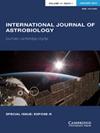绕自由漂浮行星运行的外卫星上水的存在:一个案例研究
IF 1
4区 物理与天体物理
Q3 ASTRONOMY & ASTROPHYSICS
引用次数: 7
摘要
自由漂浮行星(FFP)是一种行星质量的天体,它围绕非恒星大质量天体(如褐矮星)或银河系中心运行。围绕FFPs运行的系外卫星的存在已经被几个模型从理论上预测出来。在特定的条件下,这些卫星能够保持大气层,以确保其表面液态水的长期热稳定性。我们用一个一维的辐射-对流代码来模拟这个环境,这个代码耦合到一个气相化学网络,包括宇宙射线和离子中性反应。我们发现,在特定条件下,假设轨道参数随时间稳定,液态水可以在系外卫星表面形成。地球质量的系外卫星的最终水量比地球海洋中的水量要少,但足以承载原始生命的潜在发展。化学平衡的时间尺度是由宇宙射线控制的,宇宙射线是我们的月外大气模型中主要的电离驱动因素。本文章由计算机程序翻译,如有差异,请以英文原文为准。
Presence of water on exomoons orbiting free-floating planets: a case study
A free-floating planet (FFP) is a planetary-mass object that orbits around a non-stellar massive object (e.g. a brown dwarf) or around the Galactic Centre. The presence of exomoons orbiting FFPs has been theoretically predicted by several models. Under specific conditions, these moons are able to retain an atmosphere capable of ensuring the long-term thermal stability of liquid water on their surface. We model this environment with a one-dimensional radiative-convective code coupled to a gas-phase chemical network including cosmic rays and ion-neutral reactions. We find that, under specific conditions and assuming stable orbital parameters over time, liquid water can be formed on the surface of the exomoon. The final amount of water for an Earth-mass exomoon is smaller than the amount of water in Earth oceans, but enough to host the potential development of primordial life. The chemical equilibrium time-scale is controlled by cosmic rays, the main ionization driver in our model of the exomoon atmosphere.
求助全文
通过发布文献求助,成功后即可免费获取论文全文。
去求助
来源期刊

International Journal of Astrobiology
地学天文-地球科学综合
CiteScore
3.70
自引率
11.80%
发文量
45
审稿时长
>12 weeks
期刊介绍:
International Journal of Astrobiology is the peer-reviewed forum for practitioners in this exciting interdisciplinary field. Coverage includes cosmic prebiotic chemistry, planetary evolution, the search for planetary systems and habitable zones, extremophile biology and experimental simulation of extraterrestrial environments, Mars as an abode of life, life detection in our solar system and beyond, the search for extraterrestrial intelligence, the history of the science of astrobiology, as well as societal and educational aspects of astrobiology. Occasionally an issue of the journal is devoted to the keynote plenary research papers from an international meeting. A notable feature of the journal is the global distribution of its authors.
 求助内容:
求助内容: 应助结果提醒方式:
应助结果提醒方式:


